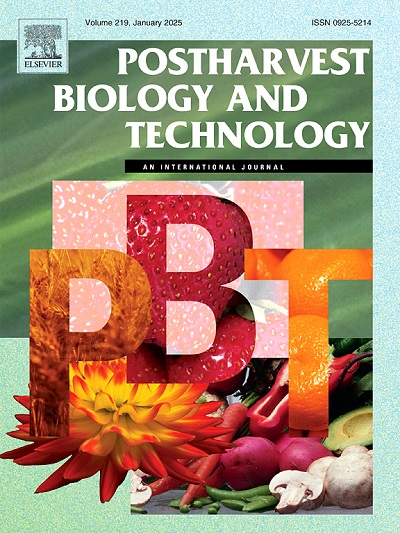褪黑素通过调控转录因子LcWRKY17促进采后荔枝花青素的生物合成
IF 6.8
1区 农林科学
Q1 AGRONOMY
引用次数: 0
摘要
荔枝果实采后果皮变色、褐变,极大地降低了产品的适销性。外源性褪黑素(MEL)是一种强大的生物活性分子,先前已被证明可以延缓荔枝果实的品质退化。本研究进一步揭示了MEL调控荔枝果实采后品质的分子机制。结果表明,400 μM MEL处理“白唐英”荔枝可明显延缓果实的发红和褐变,抑制DPPH自由基清除能力和相对电导率的变化。RTqPCR分析显示,MEL上调了花青素合成关键基因LcPAL1、LcPAL2、LcPAL3、Lc4CL、LcCHS、LcF3H和LcANS,与MEL处理果实中花青素含量升高相对应。此外,我们还发现了一个mel诱导的WRKY转录因子,该转录因子在LcPAL3、Lc4CL和lcan的启动子区域具有保守的WRKY结合W-box基序。通过启动子结合实验的功能验证表明,LcWRKY17是一个具有转录激活的核蛋白,可直接激活LcPAL3、Lc4CL和lcan的转录。综上所述,LcWRKY17介导了MEL诱导的荔枝花青素生物合成,至少部分是通过直接转录激活LcPAL3、Lc4CL和lcan,从而促进了我们对MEL延缓荔枝果实品质退化的机制的理解。本文章由计算机程序翻译,如有差异,请以英文原文为准。
Melatonin promotes anthocyanin biosynthesis in postharvest litchi fruit via regulation of the transcription factor LcWRKY17
Pericarp discoloration and browning in postharvest litchi fruit extremely reduce marketability of products. Exogenous melatonin (MEL), a robust bioactive molecule, has been previously demonstrated to delay quality deterioration in litchi fruit. The present study further uncovered the molecular mechanism of MEL in regulating postharvest quality in litchi fruit. The results showed that the application of 400 μM MEL to ‘Baitangying’ litchi fruit appreciably delayed redness loss and browning while inhibiting the changes in DPPH radical scavenging activity and relative conductivity. RT![]() qPCR analysis revealed that MEL upregulated key anthocyanin biosynthesis genes, including LcPAL1, LcPAL2, LcPAL3, Lc4CL, LcCHS, LcF3H and LcANS, which paralleled with increased anthocyanin content in the MEL-treated fruit. Furthermore, a MEL-inducible WRKY transcription factor was identified, which had a conserved WRKY-binding W-box motifs in the promoter regions of LcPAL3, Lc4CL and LcANS. Functional validation via promoter-binding assays revealed that LcWRKY17 is a nuclear protein with transcriptional activation and it directly activated the transcription of LcPAL3, Lc4CL and LcANS. In summary, the results suggest that LcWRKY17 mediates MEL-induced anthocyanin biosynthesis in litchi, at least partially through direct transcriptional activation of LcPAL3, Lc4CL and LcANS, thereby advancing our understanding of the mechanism by which MEL delays quality deterioration in harvested litchi fruit.
qPCR analysis revealed that MEL upregulated key anthocyanin biosynthesis genes, including LcPAL1, LcPAL2, LcPAL3, Lc4CL, LcCHS, LcF3H and LcANS, which paralleled with increased anthocyanin content in the MEL-treated fruit. Furthermore, a MEL-inducible WRKY transcription factor was identified, which had a conserved WRKY-binding W-box motifs in the promoter regions of LcPAL3, Lc4CL and LcANS. Functional validation via promoter-binding assays revealed that LcWRKY17 is a nuclear protein with transcriptional activation and it directly activated the transcription of LcPAL3, Lc4CL and LcANS. In summary, the results suggest that LcWRKY17 mediates MEL-induced anthocyanin biosynthesis in litchi, at least partially through direct transcriptional activation of LcPAL3, Lc4CL and LcANS, thereby advancing our understanding of the mechanism by which MEL delays quality deterioration in harvested litchi fruit.
求助全文
通过发布文献求助,成功后即可免费获取论文全文。
去求助
来源期刊

Postharvest Biology and Technology
农林科学-农艺学
CiteScore
12.00
自引率
11.40%
发文量
309
审稿时长
38 days
期刊介绍:
The journal is devoted exclusively to the publication of original papers, review articles and frontiers articles on biological and technological postharvest research. This includes the areas of postharvest storage, treatments and underpinning mechanisms, quality evaluation, packaging, handling and distribution of fresh horticultural crops including fruit, vegetables, flowers and nuts, but excluding grains, seeds and forages.
Papers reporting novel insights from fundamental and interdisciplinary research will be particularly encouraged. These disciplines include systems biology, bioinformatics, entomology, plant physiology, plant pathology, (bio)chemistry, engineering, modelling, and technologies for nondestructive testing.
Manuscripts on fresh food crops that will be further processed after postharvest storage, or on food processes beyond refrigeration, packaging and minimal processing will not be considered.
 求助内容:
求助内容: 应助结果提醒方式:
应助结果提醒方式:


